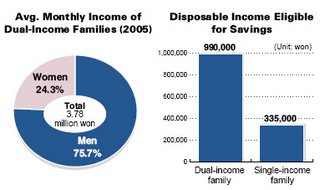
A common question American women ask is gender issues in the Korean workplace. As one who watches Korean society and workplace culture, I find the dramatic ever-increasing role of Korean women in the workplace worthy of study.
This Korea Times article and chart provides some insights that I have confirmed in my interviews and first-hand observations of the Korean workplace.
Wives contributed about a quarter of the average monthly income in dual-income households, where both the husband and wife work. [ My guts is that this number is much higher with many women in cash businesses].
According to the annual Women’s Life in Statistics, compiled by the National Statistical Office (NSO), working wives earned 916,800 won a month, accounting for some 24.3 percent of the 3.78 million won average monthly income of two-income families in Korea in 2005.
Last year, double-income households had 1.05 million won, or 38.5 percent, more monthly income than the average family with single income. The NSO surveyed 7,500 married couples nationwide.
The monthly earning gap between double and single-income families widened by 104,800 won from 2004.
Although employed women worked virtually the same number of hours last year, about 96.7 percent of the hours men worked, the average monthly salary earned by women remained only 63 percent of that made by men, increasing marginally from the previous year.
Nevertheless, there were also encouraging signs as the number of women in key government posts and professional services continued to increase steadily.
Women who became members of local councils in this year’s local elections amounted to 525, accounting for 14.5 percent of total council members, up from 3.4 percent in 2002.
Of working women, the share of those engaged in professional services increased to 17.5 percent in 2005 from 16.9 percent in 2004.
The share of female professors also rose to 18.1 percent last year from 17.2 percent in 2004.
In 2005, women made up 13 percent of Korean lawmakers, 19.2 percent of physicians and surgeons, 22.2 percent of dentists, 12.4 percent of oriental medicine practitioners, and 63.8 percent of pharmacists.
Of the total of economically productive women, or females eligible for work, 50.1 percent had jobs at the end of last year, topping the 50-percent threshold for the first time ever.
No comments:
Post a Comment